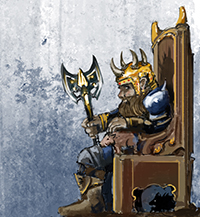Writing adventures, the humble beginning


Writing adventures for Dungeons and Dragons (and all the OGL OSR systems) is a tricky business. Where do you start? how do you make a workable adventure? Can it be published?
Whenever I begin writing adventures I have to remind myself to NOT turn on my computer. My adventures have some very humble beginnings and what follows is my process.
Basic Process
- Decide on a theme or “feel”
- Location – Where is the main action?
- Basic Challenge – What is the core goal of the quest?
- Sub plots? – Can I tuck in sub-plot quests?
- Number of encounters – This is more important than you think.
- Outline – Pencil work
- Gather all info for encounters and areas.
- Outline the WHOLE biz for writing
- Turn on the computer and write
What’s this mean?
Let me expand briefly. Writing for publication is a bit different from prepping adventures for the gang at the table. There are IP laws to consider, and things need to be solid and tested.
- Feel – Is important to keep a cohesive feeling to the quest. it dictates the kind of challenges, monsters, and villains that appear. Is it a slimy dungeon or an arid desert?
- Location – This seems obvious, but can get lost if you don’t nail it down. Your adventure might go all over the board and players start to lose the sense of completion if they can’t “close up” areas in play.
- Basic Challenge – This is the core of the adventure: Save the prince, help the villagers, kill the dragon. Easy enough, but if it isn’t written, it too can be lost.
- Sub Plots – This is a recent thing that I have brought to the forefront of my game writing. There is a world outside the main theme, and sub-plots can add extra adventure, extra goals, and added sense of accomplishment. Rewards from Griffon hunters? Beetles in the basement? It’s the adventurers version of, “While you’re here… can you open this jar of pickles deary?”
- # Encounters – Each encounter takes time and thought. This isn’t just fights but adventure entries. 20 or so will make a well-rounded adventure with many hours of play. Some groups will only get to 6-8 in a regular gaming night. If you don’t nail down your goal here, you can find yourself going from quick one-off to mega dungeon (That puts you WAY out of budget).
- Outline – Mr. James M Ward gave me the best writing advice EVER. OUTLINE – To write an outline of what you are writing and where it’s going. it will be your planning stage, and road map as you write. It allows you to skip to various parts as inspiration hits and keeps you on track.
- Gather Encounters – This means I build basic ideas for traps, monster stats, how many HD will challenge the party, roll up NPCs etc.
- Outline the WHOLE BIZ – Again, thank you Jim Ward. This is the second outline where you actually organize adventure flow, pop in some titles and add in your final notes (The first outline likely has a boat load of arrows)
- Turn on the computer – Up to this point EVERYTHING is done in a notebook with pencil. The simplest of tools get out-of-the-way to allow creation. Trying to do notes on a computer (for me) is a distraction. It doesn’t allow for spontaneous doodles, side notes, and scribbles.
There obviously is no RIGHT way, but this is my way. Adventures begin most humbly with a pencil, a rule book (Often OSRIC or now Labyrinth Lord AEC), a notepad and some tea. Sometimes I’ll toss in a piece of graph paper…. but not usually.
Finally – Chris Clark gave me some great advice as well. Always ask “Why”. Why is the villain doing this? Why is this room here? Why is the otyugh playing racquetball? Answering these gives some logic to the adventure.
I hope this helps others in writing adventures for their game tables and the world.
~Lloyd Metcalf



